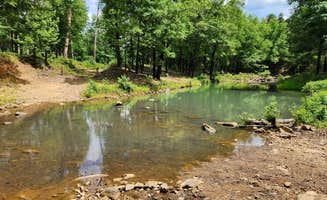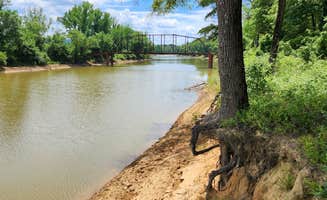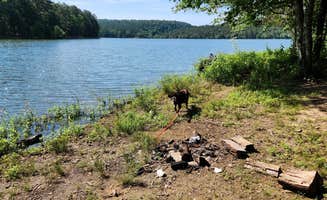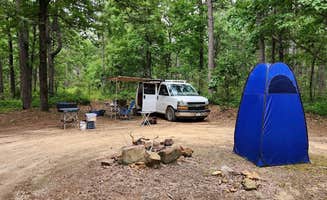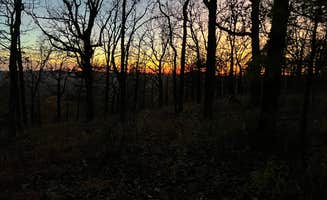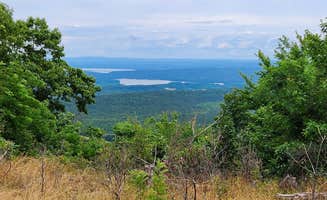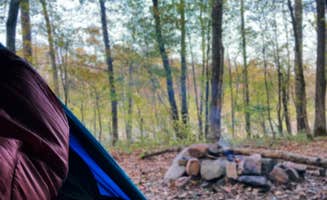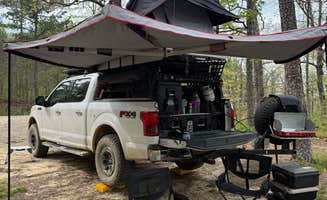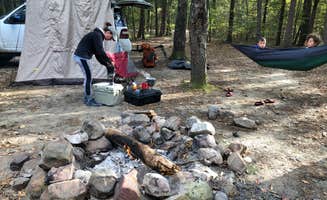Dispersed camping near Ouachita National Forest offers secluded sites within the 1.8 million acre forest that spans eastern Oklahoma and western Arkansas. Forest roads access numerous primitive camping locations throughout the Ouachita Mountains, with elevations ranging from 600 to over 2,600 feet. Seasonal considerations affect site accessibility, with spring bringing muddy conditions to many forest service roads.
What to do
Hiking opportunities: The Jack Creek area features multiple swimming holes and hiking trails accessible by vehicle. Fred S. notes, "The Sugar Creek hiking trail is a short drive away" from several primitive sites near Jack Creek Road.
Creek exploration: Several dispersed sites provide creek access for fishing or cooling off. According to Fred S., one "large wooded dispersed campsite has a short path down to Jack Creek. Depending on the water level, fishing and wading are possible at the creek."
Wildlife observation: The Ouachita Mountains host diverse wildlife populations. Jeff P. describes the area as "a hunting paradise" where they "spotted over ten deer hunters in the area in a single day" during hunting season.
What campers like
Privacy and seclusion: Many campers appreciate the solitude of Blue Knob Road in Ouachita National Forest. Heather C. shares, "You're in the middle of nowhere and it's gorgeous!" while Fred S. describes his experience as "very peaceful. Convenient for hiking in a beautiful forest."
Waterfront access: Some primitive sites feature lake and creek frontage. Matthew J. says about Irons Fork, "The place was beautiful and had plenty of lake access points too. I went in mid July so it was hot and humid but I was able to swim a bit to help that."
Natural surroundings: The undeveloped nature of dispersed sites appeals to those seeking authentic outdoor experiences. Jacob describes Turner Creek Road as "Very secluded spot no amenities just a rock fire ring. Very peaceful."
What you should know
Vehicle requirements: Forest roads vary in condition and may limit access. Carlos P. warns about Blue Knob Road, "I have a CDL and back stuff all day. Don't try to pull in. Back in off the Buck Mountain."
Amenities and preparation: Most dispersed sites have minimal facilities. Fred S. describes Jack Creek Dispersed as having "a clean rock fire ring" but no other amenities, requiring campers to be self-sufficient.
Site conditions: Weather impacts the terrain significantly. Regarding Jack Creek Road, Fred S. details, "Jack Creek Road is a mixed dirt/gravel road, wider than a single track; it is well maintained with some minor erosion in a few places."
Cell coverage: Connectivity varies by location and carrier. In some areas like Girard Road, Fred S. received "a strong T-Mobile 5G signal" while at other sites he notes "no T-Mobile cell service."
Tips for camping with families
Site selection: Choose established dispersed areas with level terrain for easier setup. At Mena Arkansas, Ernest W. describes it as a "Good secluded spot for Privacy" which works well for families seeking separation from other campers.
Swimming options: During hot months, sites near water provide natural recreation. Matthew J. shares about Irons Fork, "I was able to swim a bit" to deal with summer heat.
Wildlife awareness: Prepare for potential wildlife encounters. Matthew J. advises, "It is black bear country, so just be smart about your waste and food storage."
Bathroom considerations: Facilities are typically primitive or nonexistent. Charity S. recommends, "I used my own pop up toilet as there's is not close to being clean."
Tips from RVers
Size limitations: Larger RVs may struggle on forest roads. Heather C. explains about Fourche Mountain, "We were the only folks staying overnight. Most people were using site to launch boats... Note, site is a little uneven, so chocks were helpful."
Parking challenges: Vehicle positioning requires planning at many sites. According to Fred S., sites vary widely in capacity, from those that "can easily accommodate 2 vehicles, truck camper size and smaller, parked one behind the other" to larger areas that "can accommodate 4 rigs - truck camper size and smaller."
Bridge constraints: Some forest roads have infrastructure limitations. Fred S. warns, "There are a couple of bridges on FR76 west of the campsite that are very narrow with railings; may be too narrow for a truck camper and larger to pass through."



